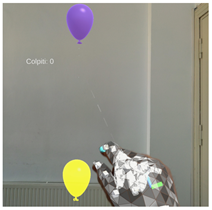
Application fields
Biomedical Engineering, Neurology, Human-Computer Interaction
Technologies
eXtended Reality (Hololens 2)
Goals
Parkinson’s Disease (PD) is a neurodegenerative disorder of the central nervous system. PD is the most frequent of movement disorders, resulting chronic and slowly progressive, involving different motor, behavioural and cognitive functions, affecting consequently patient’s quality life. In the last few years, technological progress has provided several extended reality (XR) applications for PD, both in diagnostic and rehabilitation fields. In this scenario, the main aim of the present study is to investigate the use of an XR-based system such as a support diagnostic tool to assess bradykinesia, referring to finger-tapping gestures, in parkinsonian patients. Bradykinesia is the most common symptom of PD. It is characterized by extreme difficulty and slowness on the part of the patient in performing even the simplest movements, resulting in a general sense of fatigue. The evaluation of bradykinesia thus allows an indication of the state of the disease.
The idea of the project was born from the collaboration of a multidisciplinary group composed of engineers from AHReMLab group of the Department of Electrical Information and Technology Engineering, University of Naples Federico II, and neurologists of the Department of Neuroscience, Reproductive Sciences and Dentistry, University of Naples Federico II.
The following research goals are defined:
- to investigate the feasibility of use, usability and tolerability of the proposed XR-based system;
- investigate whether the proposed system can be applied in the evaluation of neuro-psychological alterations, such as visual-spatial and executive dysfunctions, and in motor and cognitive rehabilitation of PD patients.
Activities
- design and development of an XR application using serious games framework;
- recording and monitoring the movements of the user using a multisensory approach;
- assessing interactions of PD patients with the proposed XR system;
- clinical validation of the developed XR-based system in diagnostic setting.
Figure 1 Experimental session with PD patients during the clinical validation.
Challenges
- Technology challenges: recording complete hand tracking in XR application; developing a monitoring platform to monitor the performances of patients.
- Clinical challenges: validate the use of XR applications in diagnostic and rehabilitation settings for PD.
Bibliography
[1] D. G. Grosset, G. J. A. Macphee, and M. Nairn, “Diagnosis and pharmacological management of Parkinson’s disease: summary of SIGN guidelines,” BMJ, vol. 340, p. b5614, Jan. 2010, doi: 10.1136/bmj.b5614.
[2] R. Balestrino and A. H. V Schapira, “Parkinson disease,” Eur. J. Neurol., vol. 27, no. 1, pp. 27–42, 2020.
[3] M. Riccò et al., “Prevalence of Parkinson Disease in Italy: a systematic review and meta-analysis,” Acta Bio Medica Atenei Parm., vol. 91, no. 3, p. e2020088, 2020.
[4] W. Poewe et al., “Parkinson disease,” Nat. Rev. Dis. Prim., vol. 3, no. 1, pp. 1–21, 2017.
[5] C. G. Canning, N. E. Allen, E. Nackaerts, S. S. Paul, A. Nieuwboer, and M. Gilat, “Virtual reality in research and rehabilitation of gait and balance in Parkinson disease.,” Nat. Rev. Neurol., vol. 16, no. 8, pp. 409–425, Aug. 2020, doi: 10.1038/s41582-020-0370-2.
[6] Y. Lu et al., “The Effectiveness of Virtual Reality for Rehabilitation of Parkinson Disease: An Overview of Systematic Reviews and Meta-Analyses,” 2021.
[7] J. Amirthalingam et al., “Virtual Reality Intervention to Help Improve Motor Function in Patients Undergoing Rehabilitation for Cerebral Palsy, Parkinson’s Disease, or Stroke: A Systematic Review of Randomized Controlled Trials.,” Cureus, vol. 13, no. 7, p. e16763, Jul. 2021, doi: 10.7759/cureus.16763.
[8] K. Dockx et al., “Virtual reality for rehabilitation in Parkinson’s disease.,” Cochrane database Syst. Rev., vol. 12, no. 12, p. CD010760, Dec. 2016, doi: 10.1002/14651858.CD010760.pub2.
[9] T. J. Riess, “Augmented reality in Parkinson’s disease.,” Cyberpsychology Behav. impact Internet, Multimed. virtual Real. Behav. Soc., vol. 2, no. 3, pp. 231–239, 1999, doi: 10.1089/cpb.1999.2.231.
[10] S. Weghorst, “Augmented Reality and Parkinson’s Disease,” Commun. ACM, vol. 40, no. 8, pp. 47–48, 1997, doi: 10.1145/257874.257884.
[11] I. T. Paraskevopoulos, E. Tsekleves, C. Craig, C. Whyatt, and J. Cosmas, “Design guidelines for developing customised serious games for Parkinson’s Disease rehabilitation using bespoke game sensors,” Entertain. Comput., vol. 5, no. 4, pp. 413–424, 2014.





